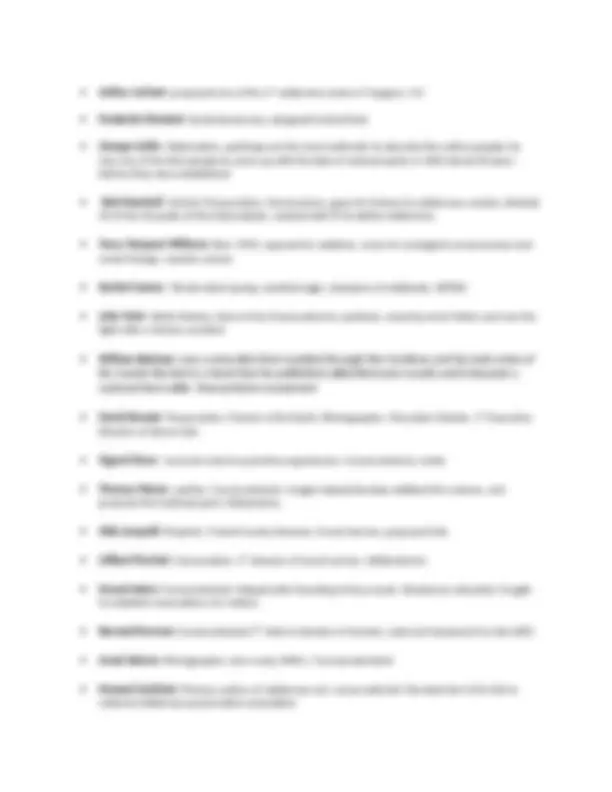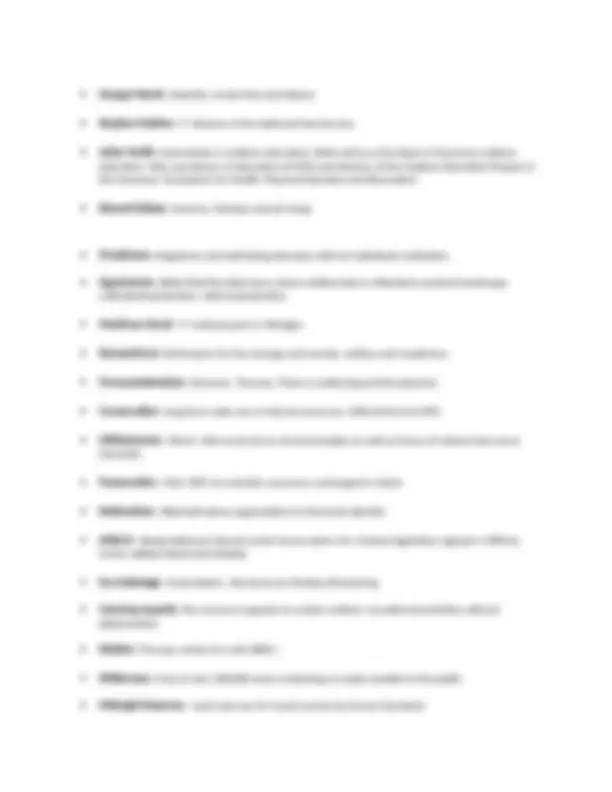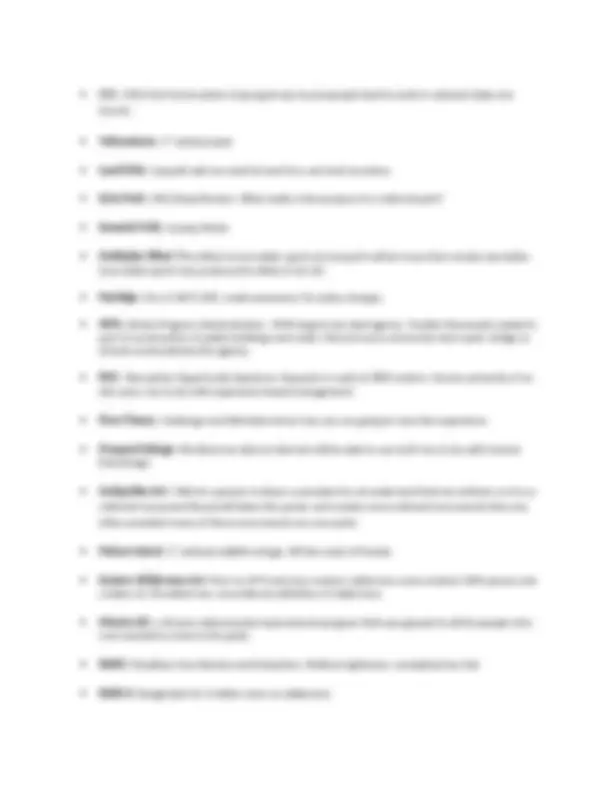





Study with the several resources on Docsity

Earn points by helping other students or get them with a premium plan


Prepare for your exams
Study with the several resources on Docsity

Earn points to download
Earn points by helping other students or get them with a premium plan
Community
Ask the community for help and clear up your study doubts
Discover the best universities in your country according to Docsity users
Free resources
Download our free guides on studying techniques, anxiety management strategies, and thesis advice from Docsity tutors
An overview of various us federal agencies and their roles in conservation, multiple use, preservation, and outdoor recreation. Agencies include the department of the interior, usda forest service, and national park service, among others. Topics covered include the history of wilderness areas, the role of various non-profits, and ways to count visits to these areas.
Typology: Study notes
1 / 6

This page cannot be seen from the preview
Don't miss anything!




Department of the Interior Bureau of Land Management : Conservation, Multiple use, Mission is to sustain health Diversity and productivity of public lands range, timber, recreation, soil conservation and watershed National Park Service : Preservation, single use, mission is to preserve the natural and cultural resources for education and enjoyment US Fish and Wildlife : Conservation, Protect and enhance fish, wildlife, plants and their habitats for continuing benefit of U.S. citizens Bureau of Reclamation : Multiple Use. To manage, develop, and protect water and related resources in a n environmentally/economically sound way USDA Forest Service : Conservation, Multiple Use. Mission is to ensure the long term health, diversity, and productivity of the land LWCF : Land and Water Conservation Fund. It is administered by the National Park Service. Funding comes from; user entrance fees, motorboat fuel tax, 50% matching from federal government. Focuses on land acquisition. SCORP Report: Statewide Comprehensive Outdoor Recreation Plan Gila Wilderness: New Mexico, 1st^ Wilderness area. Created 1924 National Conference on Outdoor Recreation was in 1924 USDA Primitive Area Survey in 1929 was an administrative effort to begin to define wilderness The wilderness society was established in 1935 1939 USDAFS makes U-Regulations, classifies wilderness 1964 Wilderness Act National Wilderness Preservation System was made in 1964 Forest service manages most areas, Park Service manages most acres Pelican Island, FL: 1st^ national wildlife refuge Wrangel-St Ellis, AK: Largest wilderness area (AK) – 12,743,349 acres Smallest area: Rocks and Islands Wilderness (CA) – 5 acres California has most wilderness areas – 138 areas Michigan has 15 wilderness Areas Smallest Wilderness Area in Michigan is Huron Island Wilderness Ways to Count Visits o Recreation Visits (V) – one entry per person o Recreation Visitor Day (RVD) – one entry for every 12 hours of recreation
o Recreation Visitor (RV) – 1 entry per person regardless of number of visits o Activity Occasion (AO) – 1 entry per person participating in each recreation activity o Recreation Visitor Hour (RVH) – 1 entry for every 60 minutes of recreation Ways to get this information o Voluntary Registration of Permits o Mandatory Registration of permits o Visual observation o Traffic counters DNRE o Department of Natural Resources and Environment o Responsible for stewardship of MI natural resources and for the provision of outdoor recreation opportunities o Current director is Rebecca Humphries o Wildlife view ^, Fishing, Hunting, Snowmobiling ^, Boating 4 National Parks in Michigan o Isle Royale National Park o Pictured Rocks National Lakeshore o Keweenaw National Park o Sleeping Bear Dunes National Lakeshore Largest Non-Profit in U.S.- Nature Conservancy Oldest Non-Profit in U.S.- Sierra Club 5 Phases of the Outdoor Recreation Experience
Important figures Thoreau : Transcendentalist, Historian, Walden Pond 1845 wrote Walden Emerson : Transcendentalist wrote Nature
George Marsh: Scientist, wrote Man and Nature Stephen Mather: 1 st^ director of the National Park Service Julian Smith: early leader in outdoor education. Referred to as the Dean of American outdoor education. Was a professor of education at MSU and director of the Outdoor Education Project of the American Association for Health, Physical Education and Recreation Edward Abbey: Anarchy, Monkey wrench Gang Primitivism : Happiness and well-being decrease with an individuals civilization Agrarianism : Belief that the ideal man-nature relationship is reflected in pastoral landscape, cultivated=productive, wild=unproductive Mackinac Island : 1st^ national park in Michigan Romanticism : Enthusiasm for the strange and remote, solitary and mysterious Transcendentalism : Emerson, Thoreau, There is reality beyond the physical Conservation : long term wide use of natural resources, Gifford Pinchot USFS Utilitarianism : Marsh, Man must act on moral principles as well as forces of nature have more character Preservation : Muir, NPS, to maintain resources unchanged or intact Nationalism : Attached nature appreciation to American identity ANILCA : Alaska National Interest Lands Conservation Act. Federal legislation signed in 1980 by Carter settled Alaska land debate Eco-Sabotage : Ansel Adams. Also know as Monkey Wrenching Carrying capacity : the resource capacity to sustain outdoor recreational activities without deterioration Walden : Thoreau writes it in mid 1800’s Wilderness : Area of over 100,000 acres containing no roads useable to the public Midnight Reserves : Land reserves for forest service by Grover Cleveland
CCC : 1933 Civil Conservation Corps goal was to put people back to work in national state and forests Yellowstone : 1st^ national park Land Ethic : Leopold said we need to treat it as we treat ourselves Echo Park : 1952 David Brower. What really is the purpose of a national park? Sewards Folly : buying Alaska Multiplier Effect: T he effect of one dollar spent at one point will be more than merely one dollar. (one dollar spent may produce the effect of $1.53) Peshtigo : Fire of 1871 (WI), made awareness for policy changes WPA : Works Progress Administration. 1939 largest new deal agency. Franklin Roosevelt created it, part of construction of public buildings and roads. Almost every community had a park, bridge or school constructed by the agency. ROS : Recreation Opportunity Spectrum. Expands in roads to EBM system, focuses primarily of on site users, has to do with experience based management. Flow Theory : Challenge and Skill determines how you are going to view the experience. Prospect Refuge : We like to be able to hide but still be able to see stuff, has to do with Central Park design Antiquities Act : 1906 it is passed, it allows a president to set aside land that has artifacts on it as a national monument Roosevelt takes this power and creates more national monuments than any other president many of those monuments are now parks Pelican Island : 1st^ national wildlife refuge. Off the coast of Florida Eastern Wilderness Act : Prior to 1973 only four eastern wilderness areas existed. EWA passes and creates 16. Provided new, more liberal, definition of wilderness. Mission 66 : a 10 year national park improvement program that was geared to all the people who now wanted to come to the parks RARE I : Roadless Area Review and Evaluation. Political nightmare, completed too fast RARE II : Designated 15.4 million acres as wilderness.